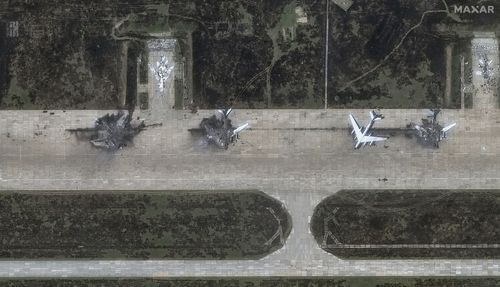Share this @internewscast.com
Dubbed âOperation Spiderweb,â Ukraine claimed the operation either destroyed or damaged over 40 aircraft stationed near Russian air bases on Sunday, striking a blow not only to the Kremlin’s standing.

It was also a wake-up call for the West to bolster its air defense systems against such hybrid tactics, military experts said.
Ukraine leveraged the recent advancements in low-cost drone technology, combining it with innovative strategies to achieve a morale-boosting success in the ongoing war, now in its third year, which has recently been tilting in Moscow’s favor.
How deeply the attack will impact Russian military operations is unclear.
While officials in Kyiv estimated the damage at $7 billion, the Russian Foreign Ministry contested this figure, and no independent evaluations have been confirmed.
Moscow still has more aircraft to launch its bombs and cruise missiles against Ukraine.
Still, the operation showed what âmodern war really looks like and why itâs so important to stay ahead with technology,â said Ukrainian President Volodymyr Zelenskyy.
Where the West is vulnerable
For Western governments, it’s a warning that âthe spectrum of threats theyâre going to have to take into consideration only gets broader,â said Douglas Barrie, senior fellow for military aerospace at the International Institute of Strategic Studies in London.
In the past decade, European countries have accused Russia of carrying out a sabotage campaign against the West, with targets ranging from defense executives and logistics companies to businesses linked to Ukraine.
Unidentified drones have been seen in the past year flying near military bases in the US, the UK and Germany, as well as above weapons factories in Norway.
High-value weapons and other technology at those sites are âbig, juicy targets for both state and non-state actors,â said Caitlin Lee, a drone warfare expert at RAND in Washington.
âThe time is nowâ to invest in anti-drone defenses, she said.

Low-cost options to protect aircraft include using hardened shelters, dispersing the targets to different bases and camouflaging them or even building decoys.
U.S. President Donald Trump last month announced a $175 billion âGolden Domeâ program using space-based weapons to protect the country from long-range missiles.
Not mentioned were defenses against drones, which Lee said can be challenging because they fly low and slow, and on radar can look like birds.
They also can be launched inside national borders, unlike a supersonic missile fired from abroad.
Drones âdramatically increaseâ the capacity by a hostile state or group for significant sabotage, said Fabian Hinz, a missile expert and research fellow at IISS.
âHow many targets are there in a country? How well can you defend every single one of them against a threat like that?â he said.
Ukraine’s resourceful, outside-the-box thinking
In âOperation Spiderweb,â Ukraine said it smuggled the first-person view, or FPV, drones into Russia, where they were placed in the wooden containers and eventually driven by truck close to the airfields in the Irkutsk region in Siberia, the Murmansk region in the Arctic, and the Amur region in the Far East, as well as to two bases in western Russia.
Ukraineâs Security Service, or SBU, said the drones had highly automated capabilities and were partly piloted by an operator and partly by using artificial intelligence, which flew them along a pre-planned route in the event the drones lost signal.
Such AI technology almost certainly would have been unavailable to Ukraine five years ago.
SBU video showed drones swooping over and under Russian aircraft, some of which were covered by tires.
Experts suggested the tires could have been used to confuse an automatic targeting system by breaking up the plane’s silhouette or to offer primitive protection.
âThe way in which the Ukrainians brought this together is creative and obviously caught the Russians completely off guard,â Barrie said.

Satellite photos analysed by The Associated Press showed seven destroyed bombers on the tarmac at Irkutsk’s Belaya Air Base, a major installation for Russiaâs long-range bomber force.
At least three Tu-95 four-engine turboprop bombers and four Tu-22M twin-engine supersonic bombers appear to be destroyed.
Since the beginning of Russia’s full-scale invasion in 2022, the outgunned and outnumbered Ukrainian military has adopted a creative approach to warfare.
Its forces deployed wooden decoys of expensive US HIMARS air defense systems to draw Russia’s missile fire, created anti-drone units that operate on pickup trucks, and repurposed captured weapons.
Experts compared Sunday’s attack to Israelâs operation last year in which pagers used by members of the militant group Hezbollah exploded almost simultaneously in Lebanon and Syria.
Israel also has used small, exploding drones to attack targets in Lebanon and Iran.
The U.S. used Predator drones more than a decade ago to kill insurgents in Afghanistan from thousands of miles away.
Developments in technology have made those capabilities available in smaller drones.
Hinz compared the state of drone warfare to that of the development of the tank, which made its debut in 1916 in World War I.
Engineers sought to work out how to best integrate tanks into a working battlefield scenario â contemplating everything from a tiny vehicle to a giant one âwith 18 turretsâ before settling on the version used in World War II.
With drones, âwe are in the phase of figuring that out, and things are changing so rapidly that what works today might not work tomorrow,â he said.
How the attack affects Russian operations in Ukraine
The Tu-95 bombers hit by Ukraine are âeffectively irreplaceableâ because they’re no longer in production, said Hinz, the IISS expert.
Ukraine said it also hit an A-50 early warning and control aircraft, similar to the West’s AWACS planes, that coordinate aerial attacks. Russia has even fewer of these.
âWhichever way you cut the cake for Russia, this requires expense,” said Thomas Withington of the Royal United Services Institute in London.
“You can see the billions of dollars mounting up,â
Russia must repair the damaged planes, better protect its remaining aircraft and improve its ability to disrupt such operations, he said.

Ukraine holds first football tournament for war-wounded amputees
Experts also suggested the strikes could force Moscow to speed up its program to replace the Tu-95.
While underscoring Russian vulnerabilities, itâs not clear if it will mean reduced airstrikes on Ukraine.
Russia has focused on trying to overwhelm Ukraineâs air defenses with drones throughout the war, including the use of decoys without payloads.
On some nights last month, Moscow launched over 300 drones.
âEven if Ukraine was able to damage a significant portion of the Russian bomber force, itâs not entirely clear that the bomber force was playing a linchpin role in the war at this point,â Lee said.
Ukrainian air force data analyzed by AP shows that from July 2024 through December 2024, Russia used Tu-22M3s and Tu-95s 14 times against Ukraine but used drones almost every night.
Sunday’s operation might temporarily reduce Russiaâs ability to launch strategic missile attacks but it will probably find ways to compensate, Lee said.










